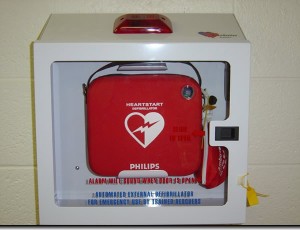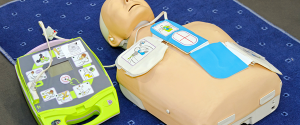Sudden cardiac arrest (SCA) is one of the worldwide leading causes of death and in the US alone, around 250,000 people die each year, according to the Center for Disease Control and Prevention (CDC). More people die each year from SCA than they do from colorectal, breast, and prostate cancer, AIDS, car accidents, and guns. That’s pretty remarkable, when you think about it in those terms, right? There are some pretty simple things that you can do to help a victim of sudden cardiac arrest, and you never know when you might be in the position to help save someone’s life!
What is Sudden Cardiac Arrest (SCA)?
SCA is different from a heart attack, but a heart attack (which is a build up of plaque in the arteries that bring blood to the heart, leading to a decreased blood flow, so the heart is not working optimally, but still getting some blood flow) can lead to SCA. SCA is a sudden and immediate loss of cardiac function, that also causes respiratory issues (i.e. trouble breathing/moving air in and out of your lungs), a loss of consciousness, and an arrhythmia (a disorganized rhythm that doesn’t allow your heart to pump blood out to your brain, arms/legs, or other organs). This can be really troubling because many times people do not know that they may have some sort of underlying heart disease, or be at risk for SCA. It can just happen, at the most unexpected times, and a victim will literally just drop unconscious without any warning signs. Without immediate treatment (i.e. within 10 minutes, but preferably less) people will die from SCA, or suffer major brain injuries due to a lack of blood flow and oxygen to the brain, even if we can restart the heart in a normal (perfusing) rhythm.

Compressions (CPR) 2 inches (4cm) in at least 100 times/minute

How to visualize an AED in public
What can I do?
Well, the immediate treatments for SCA are cardiopulmonary resuscitation (CPR) and defibrillation. The days of having to give “mouth to mouth” are long over, and the American Heart Association encourages bystanders to do “hands only CPR” in which you check to see if the person is responsive, and if they are not, call 911 (or your emergency number) to get help, and push on the lower half of the breast bone with your two hands interlaced, using the palms to push at least 2″ (4cm) in on the chest, and allowing for the chest to go back to its normal position, and continue on at a rate of at least 100 times per minute (to the beat of “Stayin’ Alive”.) Immediate CPR alone can help victims of SCA tremendously, and getting trained healthcare professionals called out to help ASAP is key. But there is one other thing that you can do: defibrillate (AKA Shock). What does that mean?!? Basically, defibrillation is a large electrical shock that you give to a victim to try to kick them out of that arrhythmia where there heart is not pumping blood out, and get them back into a normal perfusing rhythm. Defibrillating, is like hitting a “reset” button for the heart. And it sounds scary thinking that you are sending an electrical shock into someone’s heart, but it can only help them, and it won’t hurt them; if you don’t do it they could die, and if you do it, you can immediately save their life!! How great is that. Plus, it couldn’t be easier!

How do I defibrillate someone?
In the hospital, we have some pretty fancy defibrillators that definitely need some training to use, but in public places like libraries, gyms, hotels, sports arenas, restaurants, office buildings, stores, etc. there are automatic external defibrillators (AEDs) that could not be easier to use, and have three steps:
1. Turn the AED on (for most, opening them up turns them on) and the machine will prompt you through the next steps
2. Attach the two pads to the victim (there are pictures on the AED and on the pads): one on the upper right chest, right below the collar-bone, and the other on the left side of the chest, under the arm on the lower half of the ribcage. Once these are attached, you need to ensure you are not touching the victim, and it will analyze the rhythm. If it determines the victim needs to be defibrillated (get shocked), it will charge itself.
3. Press the defibrillate/shock button (it will light up) then immediately start compressions again. If no shock is indicated, immediately restart compressions.
*The machine will prompt you the rest of the time to continue CPR and count down the two minutes until it needs to analyze the heart’s rhythm again and the sequence will restart. It truly could not be easier!
To think that somethings that seem so easy, can save someones life? I understand that it could feel scary and uncomfortable if you aren’t used to it, but you are helping to save someone from death, and the feeling of goodness that comes over you from saving a life is amazing, and really can’t be put into words.
To recap when you find a victim of SCA:
Make sure that it is safe for you to help (you don’t want to get hurt trying to help another person, so think of your safety first)
Check for responsiveness (if they cannot speak, are not awake, then they are considered unresponsive)
Call emergency services for back up
Start chest compressions (2 inches in at a rate of at least 100 compressions per minute)
If there is an AED nearby, have someone grab it, attach the victim ASAP and follow the prompts
Continue until emergency services comes, or someone to take over from you…..if no one comes, keep going until you are exhausted.
It may seem like common sense, but when you are alone with someone in SCA, it’s important to practice and remember these steps, because your actions can help to save a victims life. I know you can do it, even if you are scared, because if you were in SCA you would want someone to help you! If you are interested in taking a Heartsaver (CPR/AED) training class, check out the American Heart Association‘s website that can tell you where local classes are held. The more training, the better!
Yours in Good Health
B





